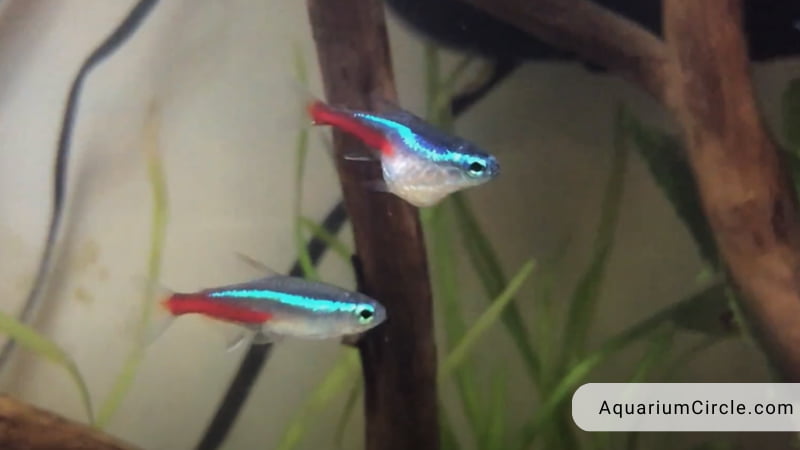Neon Tetra is a beautiful and fascinating addition to any aquarium. These small, vibrant fish are known for their iridescent blue and red stripes that add a pop of color to a fish tank. Breeding neon tetra can be an exciting and rewarding experience for any fish enthusiast. However, taking care of pregnant neon tetra requires special attention and care to ensure the health and survival of the mother and her fry.
In this article, we will explore the process of neon tetra pregnancy, preparation for neon tetra care, and tips for caring for both the pregnant fish and the fry. By the end of this article, you will have a better understanding of how to properly care for pregnant neon tetra and be ready to embark on a new and exciting journey in fish breeding.
See also:
- Are Neon Tetras Hardy? Let’s Find Out 10 Factors Affecting Their Hardiness
- Neon Tetra Lifespan – How Long Do Neon Tetras Live & Tips To Extend
- 5 Impressive Neon Tetra Fish Colors You’ll Wish You Had
Differences Between Male And Female Neon Tetra
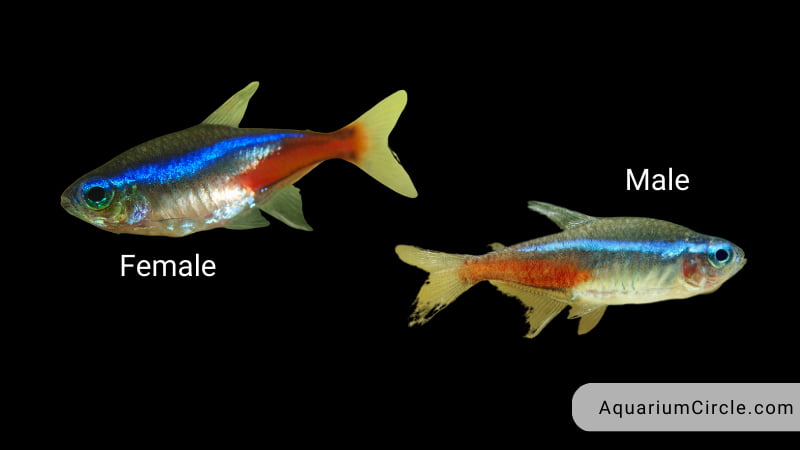
It can be difficult to distinguish between male and female neon tetras, especially when the fish are young or the aquarist is inexperienced. However, it is possible to recognize specific physical traits that separate the sexes with some effort and thorough observation. Female neon tetra have rounder and fuller belly than males, which becomes more noticeable when they are pregnant.
Additionally, female neon tetra are usually slightly larger than males. Male fish tend to have more intense and vibrant coloration than females, especially in their blue stripes. Male tetra are generally more active and tend to swim around more than females.
During breeding season, males may also chase females around the fish tank. Finally, male neon tetra often have a slightly more pointed and elongated dorsal fin than females. Knowing these differences can help you identify the gender of your neon tetra and potentially prepare for breeding if you have both male and female fish in your tank.
See also: Top 3 Characteristics To Realize Neon Tetra Fish Male And Female
How To Tell If A Female Neon Tetra Is Pregnant?
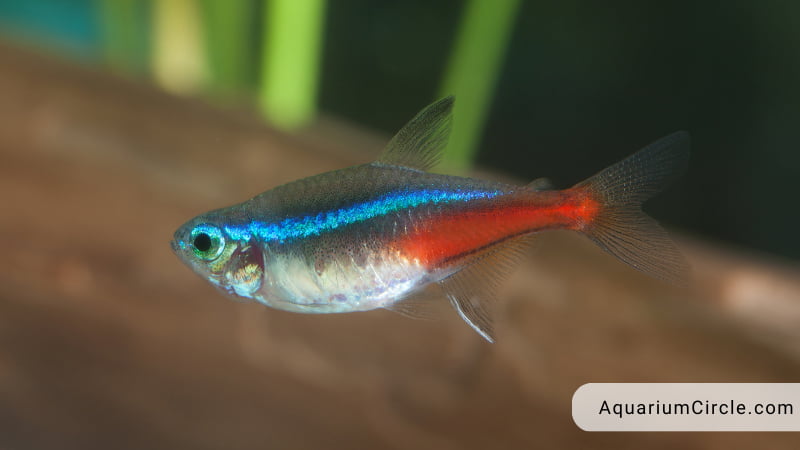
Female neon tetra can become pregnant and carry eggs inside their body before laying them. Here are some signs to look out for to tell if your female neon tetra is pregnant:
Fuller and rounder belly
When female neon tetra become pregnant, their belly will begin to swell as they develop eggs inside their body. The fuller and rounder belly is a clear indication that the fish is carrying eggs and may soon lay them. Keep in mind that some other factors such as overfeeding or bloating due to poor water quality can also cause a fuller belly in fish, so it’s important to observe other signs of pregnancy such as a distended vent or a darkened gravid spot to confirm if your neon tetra is indeed pregnant.
Distended vent
A distended vent is not necessarily a sign of a pregnant neon tetra, but it can be an indication of egg-laying or the presence of neon tetra eggs in the female fish. When a female neon tetra is ready to lay eggs, the vent may become more visible and distended as the eggs move towards it. This can make it appear as if the fish is pregnant, but it is actually a sign that the eggs are ready to be laid.
Keep in mind that a distended vent can also be a sign of other health issues such as constipation or infection, so it’s important to observe other signs of pregnancy such as a fuller and rounder belly, darkened gravid spot, slower swimming, and separation from the group to confirm if your neon tetra is indeed pregnant.
Slower swimming
When female neon tetra become pregnant, the extra weight of the neon tetra eggs they are carrying can make it more difficult for them to swim as actively as they normally would. They may swim more slowly and spend more time resting or hiding as they prepare to lay their eggs.
However, it’s important to note that slower swimming can also be a sign of other health issues, such as stress or illness, so it’s important to observe other signs of pregnancy such as a fuller and rounder belly, distended vent, darkened gravid spot, and separation from the group to confirm if your neon tetra is indeed pregnant.
Separation from the group
When female neon tetra become ready to lay their eggs, they may separate themselves from the group and seek out hiding spots as they prepare to deposit their eggs. They may also become more territorial during this time and may chase away other fish that get too close to their chosen egg-laying site.
However, separation from the group can also be a sign of stress or illness, so it’s important to observe other signs of pregnancy such as a fuller and rounder belly, distended vent, darkened gravid spot, and slower swimming to confirm if your neon tetra is indeed pregnant.
Darkened gravid spot
The gravid spot is a small, darkened area near the vent, which is the opening through which the fish excretes waste and lays eggs. As female tetra develop eggs, the gravid spot may become more pronounced and darker in color, indicating that the fish is carrying eggs and may soon lay them.
However, keep in mind that not all female neon tetra will have a visible gravid spot, and other factors such as poor water quality or disease can also cause the gravid spot to darken. Therefore, it’s important to observe other signs of pregnancy such as a fuller and rounder belly, distended vent, slower swimming, and separation from the group to confirm if your neon tetra is indeed pregnant.
How Long Is The Gestation Period Of Neon Tetra?
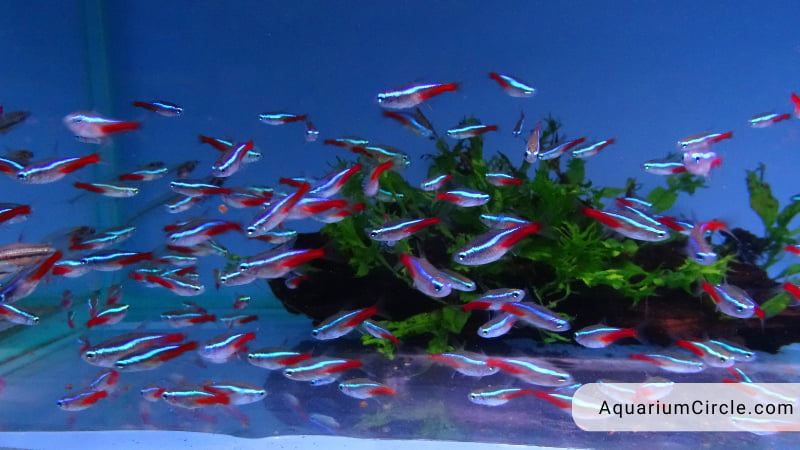
The gestation period of neon tetra is relatively short, lasting approximately 24-28 hours. During this time, the eggs will develop inside the female neon tetra’s body until they are ready to be laid. Once the eggs are laid, they will hatch within a few days, and the fry will emerge from the eggs.
It’s important to note that the gestation period of neon tetra can vary depending on factors such as water temperature and overall health of the fish, but 24-28 hours is the average range. It’s also important to ensure proper care and nutrition for pregnant neon tetra to ensure healthy egg development and hatching.
Breeding Neon Tetras Requirement
Breeding neon tetras can be an exciting and rewarding experience for fish enthusiasts. However, before embarking on this endeavor, it’s important to understand the requirements for breeding neon tetras. Here are some of the main requirements for breeding neon tetras:
- Separate breeding tank: A separate breeding tank is required to ensure the safety of the eggs and fry. The breeding tank should be well-filtered and have a heater to maintain a stable temperature.
- Water quality: The water in the breeding tank should be clean and free of toxins, with a pH level between 6.0-7.0 and a temperature around 75-80°F. Adequate filtration and regular water changes are necessary to maintain good water quality.
- Compatible mates: Breeding neon tetras requires a male and a female that are healthy and compatible. It’s important to ensure that the fish are of similar size and that the male is not too aggressive towards the female.
- Condition the fish: Before breeding, it’s important to condition the fish by providing a varied and nutritious diet to ensure healthy egg development.
- Spawning site: Neon tetras prefer to lay their eggs on fine-leaved plants or a spawning mop. Provide plenty of plant cover in the breeding tank to encourage egg-laying.
- Proper amount of light: Neon tetras require a specific light cycle to trigger spawning behavior. A 12-hour light and 12-hour dark cycle with a gradual increase in light intensity over a period of days can help induce spawning.
- Patience: Breeding neon tetras requires patience, as it can take several attempts before a successful spawn occurs. Be prepared for the possibility of eggs not hatching or fry not surviving.
By meeting these requirements, you can increase your chances of successfully breeding neon tetras and enjoy the experience of watching the development of the eggs and the growth of the fry.
How Long Does It Take For A Pregnant Neon Tetra To Lay Eggs?
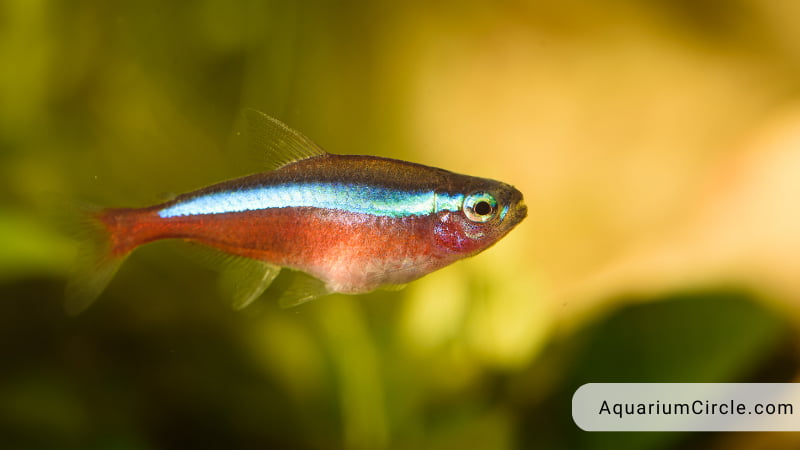
Once a female neon tetra becomes pregnant, it typically takes around 24-48 hours for her to lay the eggs. During this time, the eggs will develop inside the female’s body until they are ready to be laid. The exact timing of when the female will lay the eggs can vary depending on factors such as water temperature, lighting conditions, and overall health of the fish.
It’s important to monitor the female closely for signs of impending egg-laying, such as a distended vent, separation from the group, and increased hiding or resting behavior. Once the eggs have been laid, they will hatch within a few days, and the fry will emerge from the eggs. It’s important to provide proper care for the eggs and fry, including a suitable tank setup, clean water, and adequate nutrition, to ensure their survival and healthy growth.
How Many Eggs Do Neon Tetra Lay?
Neon tetras can lay anywhere from 60 to 120 eggs per spawn, depending on the size and health of the female. It’s important to note that not all of the eggs may hatch, and some may not survive past the larval stage. Therefore, it’s recommended to breed multiple pairs of neon tetras to increase the chances of successful egg-laying and hatching.
Once the eggs have been laid, it’s important to provide proper care for the fry to ensure their survival and healthy growth. This includes providing a suitable tank setup, clean water, and adequate nutrition. With proper care, the neon tetra fry can grow into healthy and colorful adult fish.
How To Take Care Of Neon Tetra Fry?
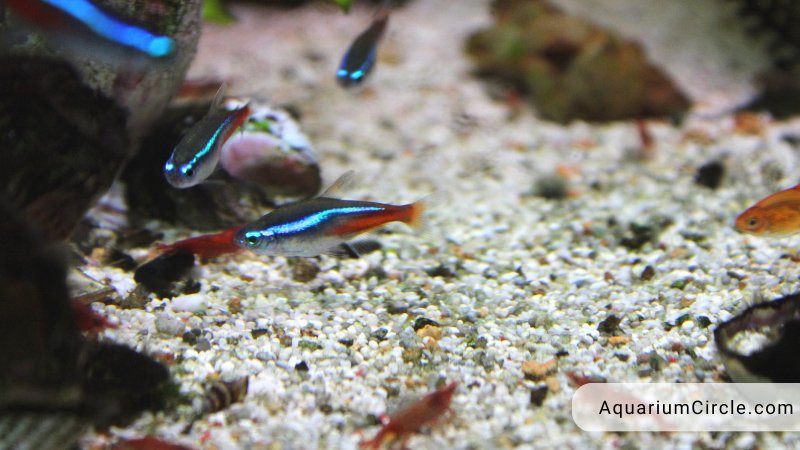
Taking care of neon tetra fry requires special attention and care to ensure their survival and healthy growth. Here are some tips on how to take care of neon tetra fry:
- Fry tank setup: Neon tetra fry should be kept in a separate tank with a sponge filter and a heater to maintain a stable temperature between 75-80°F. The tank should be well-planted with fine-leaved plants for the fry to hide in.
- Feeding: Neon tetra fry require frequent feedings of small amounts of food, such as baby brine shrimp, microworms, or commercial fry food, several times a day. It’s important to feed them small amounts at a time to prevent overfeeding and water quality issues.
- Water changes: Regular water changes are necessary to maintain good water quality in the fry tank. A 20-30% water change should be done every few days to keep the water clean and free of toxins.
- Gradual integration: As the neon tetra fry grow, they can be gradually integrated into the main tank with adult fish. This should be done slowly and carefully to avoid stressing the fry or the adult fish.
- Patience: Taking care of neon tetra fry requires patience, as it can take several weeks for them to grow large enough to be integrated into the main tank. Be prepared for the possibility of losing some fry, as not all of them may survive past the larval stage.
By providing proper care and attention to neon tetra fry, you can increase their chances of survival and enjoy watching them grow into healthy and colorful adult fish.
See also: Top Best Food For Neon Tetras And Best Places To Buy It
Is It Possible That Neon Tetras Eat Their Babies?
Yes, it is possible for neon tetras to eat their own fry. While neon tetras are generally peaceful fish, they may occasionally exhibit cannibalistic behavior, especially towards their own offspring. This is more likely to occur if the fry are not provided with adequate hiding places or if they are not fed enough food.
To minimize the chances of cannibalism, it’s important to provide the fry with plenty of plant cover and a well-rounded diet of small, frequent feedings. It’s also a good idea to remove any adult fish from the fry tank to prevent them from preying on the fry. Additionally, some hobbyists choose to use breeding nets or specialized breeding boxes to keep the fry separate from the adults until they are large enough to be integrated into the main tank.
By providing proper care and attention, you can increase the chances of the neon tetra fry surviving and growing into healthy adult fish.
Video About Pregnant Neon Tetra
Frequently Asked Questions
How do you know if a neon tetra fish get pregnant?
Female neon tetras will have a rounder belly and a slightly larger size when they are pregnant.
What is the gestation period for neon tetra?
The gestation period for neon tetra is approximately 24-28 hours.
Do neon tetras need special care when they are pregnant?
Yes, pregnant neon tetras require special care in terms of tank setup, nutrition, water parameters, and monitoring.
Can neon tetras give birth in a community tank?
Yes, neon tetras can give birth in a community tank, but it is recommended to isolate the pregnant fish in a separate breeding tank to ensure the survival of the fry.
How many fry can a neon tetra give birth to?
Neon tetras can give birth to around 60-120 fry per batch, but the number may vary depending on the size and health of the fish.
References

Annette M. Chaney is an experienced marine biologist with over 20 years of experience as an aquarist and fishkeeper. She started her first aquarium at a young age, filling it with frogs and goldfish obtained from the ten-cent pet store.
Annette grew up caring for and breeding African Cichlids, which led to a hobby in high school that doubled as a profitable means. Attending Reed College gave her time to solidify herself as an accomplished aquarium caretaker with an eye for sales. After that, from 2009 – 2013, she studied at Roger Williams University – one of the most prestigious universities for Aquaculture and Aquarium in USA. She is the founder of AquariumCircle since 2010.
